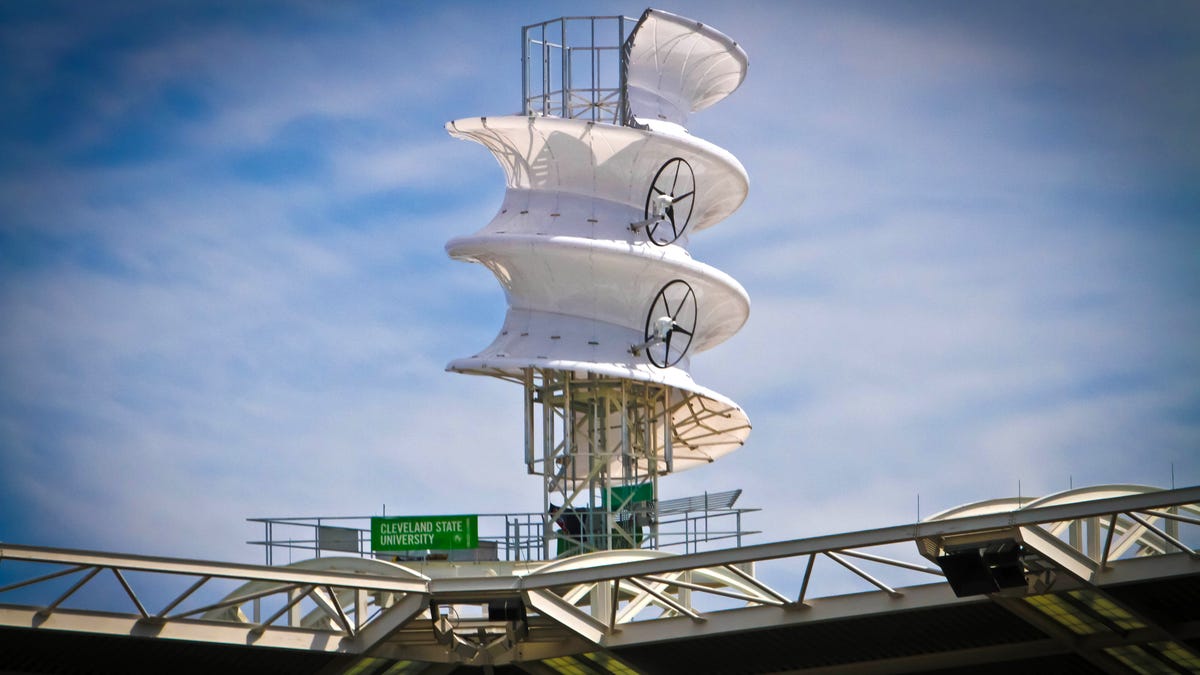Corkscrew wind turbine brings juice to Indians stadium
A quirky helix-shaped wind turbine is an experiment in boosting wind speed to make wind energy viable in low-wind locations, such as cities and suburbs.

As the Cleveland Indians play their home games, an experiment in industrial design will be spinning just overhead.
The ball park is hosting a wind turbine that uses a helix-shape tower to squeeze more power out of conventional wind turbines. The structure increases the wind speed, a technique companies have long pursued to lower the cost of wind energy.
The Progressive Field installation is a prototype designed by Majid Rashidi, a professor at Cleveland State University. The 40-foot-high, 18-foot-wide helix turbine will be installed for a year for testing and is expected to generate 40,000 kilowatt-hours a year, or enough for about four U.S. homes.
The wind turbine uses five off-the-shelf small wind turbines placed inside the grooves of the corkscrew. It's the helix shape, made of hard plastic, that boosts the power, Rashidi explained.
"Because you are creating an obstacle, you are directly funneling more wind into each turbine with the structure," he said.
In fluid dynamics modeling, Rashidi found wind amplification to be at about 1.5 times the regular rate. So if wind is at 10 miles per hour, the turbine will perform as if wind is going at 15 miles per hour. In tests with another prototype, which resembles a water tower with turbines on the sides, Rashidi found the energy output increased three or four times on a given day.
Faster wind dramatically increases power. If a structure can double the wind speed, the amount of power it will produce will increase eight times. At least two other wind startups, FloDesign Wind Turbines and Optiwind, have designs for amplification.
The lack of strong, steady wind is perhaps the biggest barrier to small wind turbines in urban or suburban areas. Some turbines don't start to generate any power until wind is around eight miles per hour, and buildings and trees create choppy wind that doesn't result in steady power production.
Rashidi's hope is that the helix design will make wind turbines financially viable in areas that don't have strong wind. Turning up the wind speed will increase the capacity factor, or the number of hours a year a turbine is operating at its full wattage rating. "This is for places where wind energy is not viable now. We're playing with the capacity factor," he said.
Rashidi doesn't have estimates for the cost of a commercial product but said he designed the prototype with manufacturing in mind in an effort to keep costs down. The plastic structure, for example, uses vacuum forming, a technique that helps lower production, he noted. Cleveland State University may license the technology to commercialize it.
Construction of the prototype was funded by a $1.1 million Department of Energy grant and found a home at Progressive Field through the Indians' sustainability efforts to educate consumers on renewable energy and generate local manufacturing jobs, a team official told the Associated Press. The turbine is expected to be connected to the grid to start generating power on site this month.
In terms of aesthetics, Rashidi said this sort of metal structure does not look out of place in an industrial city like Cleveland. "It is not an eyesore," he said.

